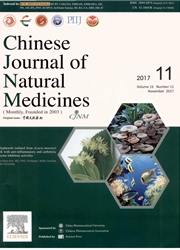

 中文摘要:
中文摘要:
目的:在抑郁症动物模型上分析姜黄素药代动力学、药效动力学及其效应特征。方法:在强迫游泳 (FST)小鼠上分别单次和重复灌胃给予 2.5, 5 和 10 mg·kg^-1姜黄素。分别测定脑区单胺氧化酶 A(MAO-A)活性及动物行为。采用 HPLC方法测定血浆中姜黄素水平。利用兼有滞后时间的二房室模型分析姜黄素药代动力学。结果:口服给予姜黄素,血药浓度峰值分别出现给药 0.75 h (单次)和 2.75-3 h (重复)后,其检测限大约在 6 h (单次)和 14 h (重复)内。毫微克级姜黄素血药浓度状态下,可呈现出 FST 小鼠 MAO-A 的抑制活性及行为的改善作用。姜黄素对 FST 小鼠攀爬、游泳、不动等异常行为的逆转作用分别在口服给药 1-2 h (单次)和 3-4 h (重复) 后达到最大效应,这与其抑制前额叶皮层和海马 MAO-A 活性的时效一致。结论:这些研究结果表明姜黄素可能不直接产生改善抑郁行为作用,其效应也可能不依赖于其血药浓度。
 英文摘要:
英文摘要:
AIM:To characterize the pharmacokinetic,pharmacodynamic and efficacy profiles of curcumin in animal model of depression.METHODS:The forced swimming test(FST) in mice was used in this study.The single and repeated(hourly for three times) oral administration of 2.5,5 and 10 mg·kg^-1 curcumin was performed in the FST.Brain monoamine oxidase A(MAO-A) in vitro and in vivo as well as behaviors were determined.The plasma curcumin concentration was analyzed using high performance liquid chromatography(HPLC) method.The pharmacokinetics of curcumin was described by a two-compartment pharmacokinetic model with a lag time in the mouse FST.RESULTS:The peak plasma concentration was observed at 0.75 h(single) and 2.75-3 h(repeated) after oral curcumin administration,and the plasma concentration was around detection limit at 6 h(single) and 14 h(repeated),respectively.Curcumin at nanogram concentrations showed monoamine oxidase A(MAO-A) inhibitory activity and behavioral improvement in the mouse FST.The maximum behavioral effects of climbing,swimming and immobility were achieved at 1-2 h(single) and 3-4 h(repeated),which paralleled that of the maximum MAO-A inhibitory effects in frontal cortex and hippocampus after oral curcumin administration in the mouse FST,respectively.CONCLUSION:These results suggest that curcumin may indirectly produce behavioral improvement,and its antidepressant potency may not be dependent on its plasma concentration.
 同期刊论文项目
同期刊论文项目
 同项目期刊论文
同项目期刊论文
 Morin reduces hepatic inflammation-associated lipid accumulation in high fructose-fed rats via inhib
Morin reduces hepatic inflammation-associated lipid accumulation in high fructose-fed rats via inhib Pharmacokinetic-pharmacodynamic Modeling of Monoamine Oxidase A Inhibitory Activity and Behavior Imp
Pharmacokinetic-pharmacodynamic Modeling of Monoamine Oxidase A Inhibitory Activity and Behavior Imp Protection of curcumin against fructose-induced hyperuricaemia and renal endothelial dysfunction inv
Protection of curcumin against fructose-induced hyperuricaemia and renal endothelial dysfunction inv Quercetin preserves beta-cell mass and function in fructose-induced hyperinsulinemia through modulat
Quercetin preserves beta-cell mass and function in fructose-induced hyperinsulinemia through modulat Antihyperuricemic and nephroprotective effects of resveratrol and its analogues in hyperuricemic mic
Antihyperuricemic and nephroprotective effects of resveratrol and its analogues in hyperuricemic mic Quercetin and allopurinol ameliorate kidney injury in STZ-treated rats with regulation of renal NLRP
Quercetin and allopurinol ameliorate kidney injury in STZ-treated rats with regulation of renal NLRP Quercetin protects against cadmium-induced renal uric acid transport system alteration and lipid met
Quercetin protects against cadmium-induced renal uric acid transport system alteration and lipid met Microglial NLRP3 inflammasome activation mediates IL-1 beta-related inflammation in prefrontal corte
Microglial NLRP3 inflammasome activation mediates IL-1 beta-related inflammation in prefrontal corte Quercetin regulates organic ion transporter and uromodulin expression and improves renal function in
Quercetin regulates organic ion transporter and uromodulin expression and improves renal function in Protective effects of cortex fraxini coumarines against oxonate-induced hyperuricemia and renal dysf
Protective effects of cortex fraxini coumarines against oxonate-induced hyperuricemia and renal dysf Quercetin inhibits AMPK/TXNIP activation and reduces inflammatory lesions to improve insulin signali
Quercetin inhibits AMPK/TXNIP activation and reduces inflammatory lesions to improve insulin signali Allopurinol, quercetin and rutin ameliorate renal NLRP3 inflammasome activation and lipid accumulati
Allopurinol, quercetin and rutin ameliorate renal NLRP3 inflammasome activation and lipid accumulati 期刊信息
期刊信息
